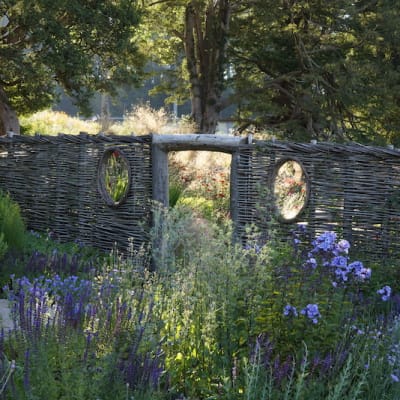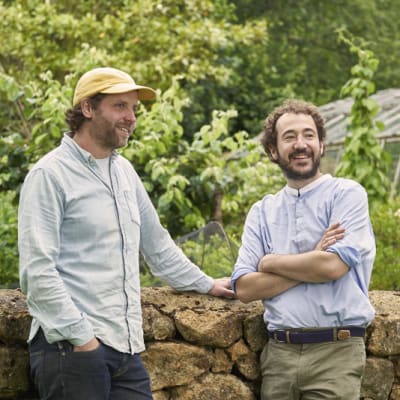The Hadspen estate has been cultivated for centuries, with farmland sustaining the livestock and edible gardens feeding the house. The gardens also have a beloved heritage and reputation for new and rare plants, thanks to keen horticulturists past.
William Player, a Gray’s Inn lawyer, and his father-in-law, Anthony Ettrick, bought much of the ancient Cary manor in the 1680s. In 1687, on some poor, naturally terraced land on the slope of Pen Hill, Player began building what he described as a ‘Gent[‘s] House’ in a field called Byflet Close’. The incomparable view south and south-west and the natural, sheltered terracing clearly offered to Player the ideal spot for a formal garden. So, over the course of the next few years he completed the new house, built walls and paved courts, planted ash, elm, white poplar and willow.

In 1695 he finished his garden at a cost of £120 ‘and planted it’, though with what plants he unfortunately did not record. In 1699 he added two fountains and brought water by lead pipes to the house. Courts, walks and fountains suggest a formal layout typical of the time, which can be seen on the earliest plan of the house and its surroundings, dated to the 1720s. On the plan we can see that the garden, planted in 1695, is divided into three clear areas, and lies to the east of the house. To the west are the farm yards, barns and a farm house.
The depiction of the trees suggests formality, with long, straight, probably terraced, walks on the slope above the house, and avenues or lines of trees. The main avenue, the forerunner of the present Avenue, begins as two single lines of trees, widely planted, in the field immediately south of the house. From the line of the road the avenue continues as double lines running towards the horizon. Another avenue runs east from the house, continuing the line of the ‘Alley’ between garden plots; a third, running west through a field called ‘Clays’, is separated by an orchard from the beginning of the main avenue.
In 1759 Mariabella Eliot, a visitor to the house, describes ‘a little cottage for a gardener’ in a ‘wild’ part of the garden (still standing, and a feature of the garden today). But what especially impressed were the vistas, the great avenue in particular ‘laid out both with regard to shape, size, hedges and plantations equal to each other, having been so done by the person that built the house for the sake of the prospect’.
Another plan, drawn in 1770 when the estate was being transferred from one owner to another, shows that a rectangular walled garden with an arched entrance has encompassed Player’s three gardens to the east of the house. The continuation of the garden then included a ‘reservoir pond, gardener’s house, cucumber garden’. At this point the landscape was still a mixture of informal woods and formal garden. The woodland above the house included a complicated network of walks and vistas, a curved structure called Settle, and a ‘Mound’ at its centre providing the views noted by Mariabella Eliot in 1759. Also in Higher Wood were what appear to be bench-seats. In Lower Wood, a vaguely triangular shape catches the eye, delineated by a fence on one side, and two walks crossing each other, one gently curved. In this we begin to make out the form of the walled parabola garden that would be built there some thirty years later.

The new owner in 1785 was Henry Hobhouse II, a Bristol lawyer, who twenty years earlier had been closely involved in the creation of a small landscape garden at Fyne Court in the Quantocks. During a journey around England and Scotland in 1774 he had visited a number of large landscape gardens, leaving detailed descriptions of Studley Royal (where the ‘stiffness’ of the waterfalls and canals was ‘the greatest fault’) and Hagley (‘where … taste and judgement … have improved and heightened the character of every view’).
His move to Hadspen involved some substantial, though not specified, changes to the house costing nearly a thousand pounds over two years, and money on the garden amounting to £23 8s 3d in 1786 and £5 3s, 6d in 1787. It seems most probable, given his interest in landscape gardens, that he completed the transition of Player’s formality to the informality of Hagley and its successors. His most striking feature, especially given the style of its entrance, was the great kitchen garden that his successors have variously called the D-garden and the Parabola.
Successive Hobhouses actively maintained and improved the gardens and woodlands, planting and felling as necessary. But no great changes came about until the arrival of Margaret Hobhouse (neé Potter), who married Henry Hobhouse V in 1880. She transformed the house and gardens, elevating them to a Victorian ideal. She commissioned and helped design two extensions to the house, the north-west wing in 1901, and the garden room in 1909. But it is in the garden itself that her legacy can be felt most keenly.

In the words of her husband; ‘The terraces, the fountain, the rockeries, the tennis court and the summer house were all designed by my wife, and she collected leaden figures and marble carvings from the “wreckers” yards to decorate them. The old stewpond was enclosed with hedges and turned into a bathing place …’. Plans for a glasshouse from 1890 show the scale and complexity of such an undertaking.

With the drafting of young men to serve in the First World War, the magnificent gardens that Margaret had so lovingly overseen and which had been ‘growing more beautiful and interesting year by year’ began to decline through shortage of gardeners. The family suffered greatly during this conflict. Two younger sons, Jack and Paul, fought on the front line, and in the autumn of 1918, with the war drawing to a close, Paul was reported missing in action. In those months of uncertainty his mother never ceased to hope and wrote to him regularly with news of home and their beloved garden:
August 30th 1918: ‘I will not however trouble you with our hopes & fears, but will tell you of the pleasant home here at Hadspen, that we keep going, awaiting the return of our loved ones. We are having glorious autumn weather, with the abundance of grapes, peaches & figs for which this old garden is famed. The autumn flowers are in full swing - the red-pokers, sunflowers, michaelmas daisies & second crop of roses. One little spray of lavender may be allowed to pass the censor.’

Paul’s body was never recovered. Largely through want of a workforce, Margaret’s garden was neglected for decades following her death in 1921, until the arrival at Hadspen of Penelope Hobhouse in 1968. In The Country Gardener, she describes Margaret’s garden as ‘designed and planted with skill and wisdom, and whose basic arrangement has given us the architectural bones. […] She added a new landscape section to the earlier more formal garden and carved terraces and steps out of parkland, which at one time reached – in the eighteenth-century landscape garden tradition – up to the front windows. She took advantage of the exciting plant discoveries being made in the Far East during the period she was re-designing and many trees and some shrubs of her choice have survived’.
Penelope set about ‘restoring’ Margaret’s garden, while by necessity maximising ease of maintenance and minimising management costs. Where Margaret had six gardeners before 1914, Penelope had just one. Bringing this space back from the ashes was a baptism of fire for Penelope and the beginning of a long and illustrious career in garden design. Her garden at Hadspen is well-described in her book, The Country Gardener.

After Penelope’s departure from Hadspen in 1979, the garden was once again without a champion for several years, until Nori and Sandra Pope arrived in the 1980s. They transformed the Parabola and cottage garden into one of the great colour gardens of England:
‘[…] all pictures have a frame, and ours is provided by the many hues of crumbling brick walls – pale buff terracotta in some areas, over-fired, almost iridescent plum in others. […] That first cold January in 1987, the plum-toned bricks, like a single opening note of a cello, told us where to begin; we now knew where the plum border would start, and so had committed ourselves to the nature of our work.’
The Popes retired in 2005 and once again the garden experienced a decade of limbo, before a new vision for the gardens was set into motion from 2014, designed by Italo-French architect, Patrice Taravella. Three varieties of plant that were created here can be found in the gardens today: Astrantia ‘Hadspen Blood’, Lobelia ‘Hadspen Purple’, and Anemone ‘Hadspen Abundance’.



